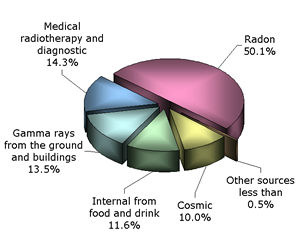News Article
Our Radioactive Home
News Story from 15th Mar 2016

Members of the Society for Radiological Protection (SRP) in hospitals, nuclear power stations, colleges and universities are well used to checking their workplaces for radioactivity. But they are also aware that some everyday objects also contain detectable amounts of naturally radioactive elements. School children visiting this week’s Big Bang Fair at the NEC Birmingham will get the opportunity to test some of these for themselves along with experienced radiation protection specialists.
SRP President physics Professor Peter Cole, Radiation Protection Officer at the University of Liverpool explains:
“All life on our planet has evolved whist being exposed to cosmic radiation from space and radioactivity from the ground. Traces of radioactive uranium and thorium are present in the rocks and soil throughout the UK, in some areas at levels that will set a Geiger counter clicking. Your souvenir pebble from Cornwall could be just such an example. The antique glass dish that came from your great-grandparents probably got its green colour because a uranium compound was used in its manufacture. And if you go camping and take a gas lantern, the mantle will almost certainly have been treated with thorium. Even at home, we all breathe in some radioactive radon gas seeping from ground. Some areas of the world have higher levels of radium and in one part of South America the deep rooted trees drawn up the radium, concentrating it in the Brazil nuts. Eating a 100g packet of Brazil nuts will give you the same radiation exposure as having a dental x-ray.
Brazil nuts aren’t the only radioactive foodstuff. Anything that contains potassium has traces of that element’s radioactive isotope potassium-40. Our bodies need potassium to keep healthy, so when we munch on potassium rich bananas we’re also eating tiny traces of radioactivity. We’re also encouraged these days to cut down on salt, sodium chloride. Some seasoning products use potassium chloride instead so it’s possible to measure the small radiation increase.
There’s another consumer product that needs a radioactive source to work effectively. Fire alarms use radioactive americium-241 to alert us when there is smoke in the air. The small radioactive source is safely contained in the detector and may even be thrown away with household rubbish when no longer required.”
The SRP will have samples of all these; Brazil Nuts, Cornish rocks, antique glassware, smoke detectors, not to mention the odd bunch of bananas on its stand at the Big Bang Fair, together with some other fun experiments designed to demonstrate the maths and science of radiation protection.
The Big Bang Fair opens Wednesday 16th - Saturday 19th March at the NEC Birmingham. For more details go to www.thebigbangfair.co.uk.
More information on the Science of Radiation Protection, as well as lesson plans for teachers, is on our web site www.srp-uk.org/public-and-schools/resouces-for-schools
More Information
The relative radiation exposure of the average member of the UK population from all sources is:

The Society for Radiological Protection, founded in 1963 and granted a Royal Charter in 2007, has over 2,200 members all involved with the safety aspects relating to the use of ionising and non-ionising radiation. It is committed to promoting the science and art of radiation protection for the public benefit. Its public outreach programme is particularly directed to school students and aims to enhance the study of science with the aim of encouraging young people to consider a career in the profession.
For more information contact:
Brian Gornall
SRP Media Officer
07836 667163
media@srp-org.uk
Fukushima – 5 Years On
Posted 10th Mar 2016

Tomorrow marks the 5 year anniversary since the disaster in Japan and in a few weeks it will be the…